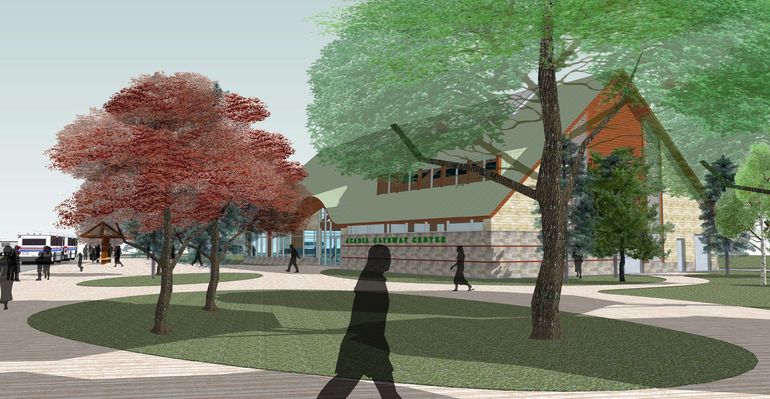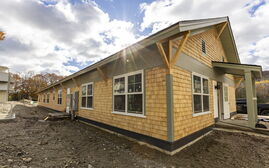
Acadia Gateway Center's $23M phase 2 construction nears groundbreaking
 Courtesy / National Park Service
Seen here is a rendering of phase-two construction of the Acadia Gateway Center in Trenton.
Courtesy / National Park Service
Seen here is a rendering of phase-two construction of the Acadia Gateway Center in Trenton.
The National Park Service is poised to start the second phase of construction of its Acadia Gateway Center, on Route 3 in Trenton, thanks to a $9 million infusion of cash from the federal government.
Phase one of the center, completed in 2012, was a bus maintenance facility, park-and-ride lot, propane fueling station, access road and administrative offices for Downeast Transportation, the nonprofit operator of the Island Explorer shuttle bus system and countywide transit systems.
Phase two will establish a full-service intermodal facility and Acadia National Park information center. That construction is expected to cost $23 million.
As of Sept. 1, the phase-two project’s funding status was 82.6% secure, with another 17.4% pending, John Kelly, Acadia’s management assistant, told the Acadia Advisory Commission during its virtual meeting held Sept. 14.
The Federal Transit Administration previously allocated $3.4 million to the project, which brings its total to $12.4 million.

Secured to date is $1 million from Friends of Acadia, $65,000 from Efficiency Maine Trust, $5.5 million from the Maine Department of Transportation and $12.4 million from the Federal Transit Administration. Pending is $4 million from the National Park Service.
“The Acadia Gateway Center has moved ahead by leaps and bounds in the last year,” Kelly said.
He added, “The $12.4 million from the Federal Transit Administration pushed it into reality. It’s just a matter of getting the National Park Service funding in place, which we hope to do in the next few months.”
In the meantime, he added, planners have moved the project from concept to preliminary design.
Phase-two construction is expected to take place from 2021 to 2023, according to Acadia National Park documents.
The project includes a visitor center, pedestrian plaza and bus berths and circulation areas for Island Explorer and commercial tour buses to line up. Level 2 electric charging infrastructure will be installed for future charging stations. The location will sell park passes and provide information on the park, bus routes and schedules, recreation opportunities, salable items such as books and maps, and information on tourist amenities. A waiting room is designed with an expanse of glass so visitors can keep an eye out for their bus.
When completed, Acadia Gateway Center is expected to benefit local and state economies, as well as address severe transit deficiencies in the region, according to a news release from the office of U.S. Sen. Susan Collins, R-Maine, which announced the fund as part of a $10.2 million package to be administered through the Federal Transit Administration’s Grants for Buses and Bus Facilities Program.
The project got its start in 2007, when Friends of Acadia purchased the 369-acre Crippens Creek property in Trenton and sold approximately 150 acres to the Department of Transportation to carry forward the center’s construction, according to the Friends of Acadia website.
The center has been the home base of the Island Explorer buses since 2011. The bus maintenance facility, tucked back well out of sight from Route 3, received LEED gold certification for its design performance in relation to human and environmental health.

Of the remaining 220 acres of land, Friends of Acadia worked with a volunteer committee and the town of Trenton to build a community behind the center, leading to a little-seen wetland in Trenton’s undeveloped interior. Called the Trenton Trail, it was inaugurated in June 2013. Friends of Acadia donated the 220 acres to the town of Trenton in December 2013.
The center sits between Ellsworth and Mount Desert Island; its location was designed to intercept traffic traveling south on Route 3 before arriving onto Mount Desert Island, according to the National Park Service.
Overall, the project is designed to:
• provide connections to the Island Explorer and other bus services;
• provide parking for visitors and commuters;
• provide administrative, light maintenance and storage facilities for Downeast Transportation Inc. in support of the Island Explorer Bus System;
• orient visitors to the Acadia region and provide visitor amenities such as restrooms; and,
• protect natural and aesthetic resources, including open space.
Because of the pandemic, the Island Explorer hasn’t been running this year. “We’re not sure what 2021 operations look like,” Kelly said.
Downeast Transportation is working on a plan for next year, he added. In the meantime, he said, the National Park Service has put in a request for federal funding to buy 21 new buses, adding to the existing fleet of 30, in order to increase capacity.
The enhanced bus service plan is part of Acadia’s plan to institute a vehicle reservation system for the park’s most popular spots. A two-week pilot of the system starts Oct. 1 at the Sand Beach entrance station and Cadillac Mountain’s summit road.














0 Comments